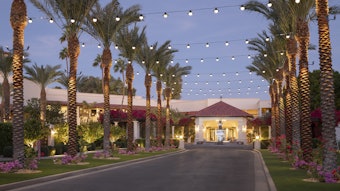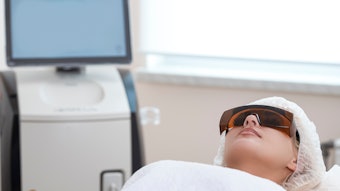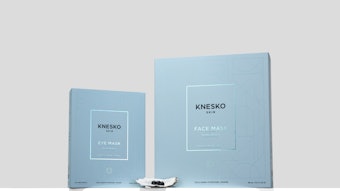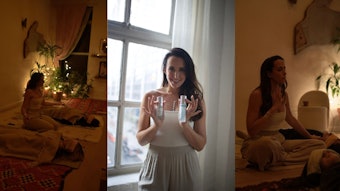“The spa at Dream is like the Chopra Center’s funky little sister,” says Alexis Ufland, whose New York-based company, Lexi Design, helped construct the new Chopra Center & Spa at Dream—a luxury hotel in New York that bills itself as ‘hautel couture.’ ”
Having opened its doors in November 2005, the spa is the sister property to the Chopra Center at La Costa Resort and Spa in Carlsbad, California. “In California, the Chopra Center has a different feel that we didn’t think would be successful in New York,” she says. “However, we still wanted to reflect the customer service and treatments with a spa that had an Indian feel that wasn’t over the top—just a touch that portrayed a modern, cool India.”
Located in an 8,000-square-foot basement space, the spa features nine treatment rooms, including a couples room, and an orange and hot pink-tiled “Udi” room—a steam area similar to a Rasul room, where clients self-apply muds and salts from the Himalayan Mountains. There also is a dedicated street-level retail space that sells jewelry, supplements, oils, teas, candles and, of course, the multitude of books written by Deepak Chopra, MD. Tucked within the spa is a 1,000-square-foot meditation room. In addition to ayurvedic-based spa treatments, the facility also offers yoga and meditation classes, as well as top-notch lectures and wellness workshops.
Creating a touch of India
Ufland and interior designer Chris Collicott— who was responsible for the design of New York’s Stone Spa—established the colorful space that pays homage to India. “When we first met Vikram Chatwal, owner of the Dream and president of the Boutique Hotel division of Hampshire Hotels and Resorts, he wanted the spa to look like an old Indian village with cobblestone tiles, but we thought that would be too much like Disneyland,” Ufland explains. “We needed something with more edge, based on the central idea behind the Chopra Center of old-world science meets modern technology—a mix of Eastern and Western medicine. We wanted to reflect the same sense with the design, creating a spa that felt like India, but incorporated modern materials.”
For example, instead of cobblestones, Ufland’s team used a patchwork of travertine tiles. Handmade sliding doors in the treatment rooms incorporate mirrored, screen-printed Plexiglas, which is reminiscent of beautiful Indian wrought iron. Nepalese artist Karla Refojo painted the 24-foot Buddha fresco in the retail boutique. “We wanted everything to shine without looking tacky,” says Ufland. “In India, colors are mixed, but that’s never done in U.S. spas, which use tan, beige and sage. To create contrast, I threw in bright pillows, and hot pink and orange tiles.”
An ayurvedic beginning
The Chopra Center in Carlsbad, California, was founded a little more than a decade ago by Chopra and David Simon, MD, based on the philosophy of merging the wise “traditions of the East and West to celebrate and explore the infinite potential of the human spirit,” according to Simon. Although the Chopra Center is not necessarily a spa, it does have a spa component. It’s a facility that Chopra has described as “a place you go to learn—either to learn about yourself, or to gain some understanding of healing or emotional freedom.”
At the time of its founding in 1995 in La Jolla, California, it lacked on-site sleeping accommodations for clients. In 2002, La Costa and the Chopra Center celebrated its five-year partnership, and established its official business headquarters and flagship location. Chopra Center clients may enjoy the full benefits of La Costa, while resort guests receive special access to the Center’s sought-after wellness programs. There are three treatment rooms at the Center, as well as a team of 14 therapists trained in ayurvedic methods. In addition, there are five treatment rooms at La Costa that are set aside specifically for Chopra Center treatments.
The ayurvedic-based treatments at the Chopra locations are administered in silence, and all were designed by Chopra and Simon. “Holding the service in silence makes the client feel like the treatment is really for them,” explains Kerry Williams, spa director. “If clients have any special needs during the treatment, of course, they are encouraged to express them. Afterward, we can discuss different ways of doing techniques, such as yoga or meditation, and how these tools help to quiet the mind.”
Carrying this ideology throughout the spa, Williams and her team meditate together every day. “It helps us all get the day off to a good start,” she notes. Each spa treatment begins with a simple questionnaire to determine the client’s primary dosha, or mind-body constitution. Unlike the Chopra Center at La Costa, this location also offers facials. The Ghandarva Harmonizing Facial is one of the more popular choices and includes a relaxing session with a singing bowl, guided meditation and marma point therapy.
Crafting teamwork
To assemble a team of dedicated professionals, Ufland interviewed more than 100 applicants during a three-part interview process. The final team included 30 employees who participated in five weeks of intense training for eight hours a day under the tutelage of Grace Wilson, a senior trainer at the Chopra Center at La Costa. She returns every two months to retrain and maintain quality control. “Our therapists had to take everything they knew and throw it out the window,” says Williams. “A lot of our treatments are choreographed and require extensive training.” Ufland adds, “The expectation is so much higher, and the therapists are rising to the expectation. The services are so much different than regular massages. They need to learn hundreds of steps and can’t miss a beat.”
Williams, whose former spa gigs include stints at New York’s spa at The Plaza Hotel and corporate sales for Bliss, says, “This has been a beautiful process to watch how the therapists train and learn. I’ve worked at quite a few spas where therapists are tested by completing a practical.” It’s this kind of training and camaraderie that ultimately benefit the client in the end. “Simon told me that the most important thing he wanted from this space was that every client feel loved when she comes to the Chopra Center. Choosing team members relied more on if they could convey the message of warmth and love, rather than their craft and experience,” says Ufland.
According to Simon, the qualities that he and his team look for include, “a sense of genuine compassion for the human condition, an inner self-awareness and an inner sense of comfort from not taking oneself too seriously, but being really responsible. We’ve done a really good job of selecting employees and of creating a sense of culture and community.” Simon hopes that the Chopra Center & Spa at Dream offers clients a seamless experience. “We started with a handful of the most basic treatments, and we’ll train on a monthly basis,” he says. “We’re learning what works, and we’re prepared to invest our time in assessing that when our clients have the same ‘wow’ feeling as they do when they come to the original location.”
Attracting a crowd
Since opening, the spa’s business is split fifty-fifty between hotel guests and local clients who frequent the facility primarily for its yoga classes. “We’re seeing the local community really respond to yoga,” says Williams, especially with the recent success of the first workshop, Primordial Sound.
So what’s next for the Chopra Center? Its intention is to spread words of wisdom and a healthy lifestyle to people across the globe. To date, there are two new properties opening within the next two years in Punta Mita, Mexico, and Westminster, Colorado.
Imitation is flattering
Spa-goers’ demand for and interest in ayurveda show no sign of diminishing. “We’ve seen a steady rise since 1995,” say Simon. “In the beginning, we were the only game in town. One of the secrets to our success is that there are so many people calling themselves ayurvedic that it’s becoming increasingly mainstream. Imitation is the sincerest form of flattery.”
When asked about those spas that may be claiming to be ayurvedic, but are anything but, he says, “We have an inherent trust in people’s ability to know the good from the bad. From our sense, we do what turns us on, what’s based on our passion. We’re never stagnant, and we’re constantly creating new things.”










